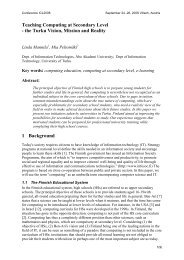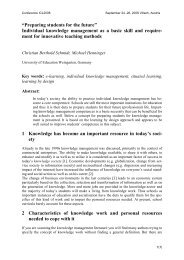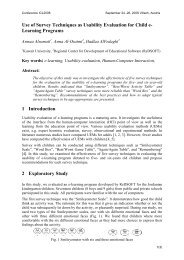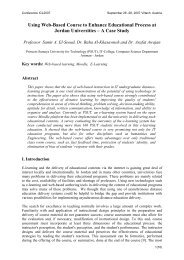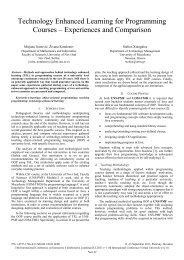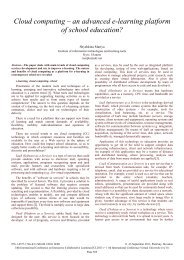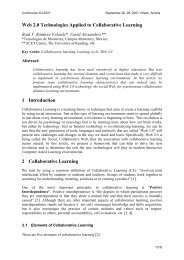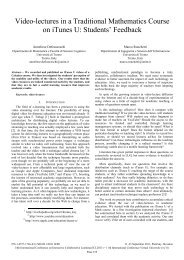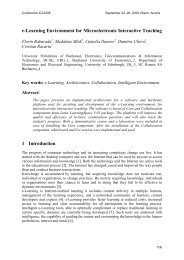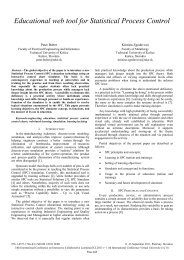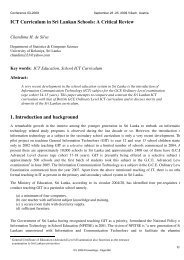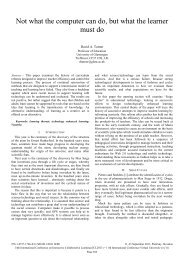Microcontrollers in Physics education: a circuit simulation ... - ICL
Microcontrollers in Physics education: a circuit simulation ... - ICL
Microcontrollers in Physics education: a circuit simulation ... - ICL
You also want an ePaper? Increase the reach of your titles
YUMPU automatically turns print PDFs into web optimized ePapers that Google loves.
Conference <strong>ICL</strong>2010<br />
September 15 -17, 2010 Hasselt, Belgium<br />
did succeed to give the <strong>in</strong>-parallel (as opposed to <strong>in</strong>-l<strong>in</strong>e) connection and b) When children<br />
work <strong>in</strong>dividually (as it was done <strong>in</strong> a previous trial of the on-l<strong>in</strong>e material) they collected<br />
from the table with the materials some cables and light bulb holders, but none asked for a<br />
second battery, while when work<strong>in</strong>g <strong>in</strong> pairs, they all collected cables, light bulb holder and<br />
an additional battery. Children <strong>in</strong> Greece are not used to work <strong>in</strong> pairs. Perhaps when they<br />
were asked to make a second light bulb illum<strong>in</strong>ate, they <strong>in</strong>terpreted the task as “the other child<br />
should make his/her own <strong>circuit</strong>”. Consequently, when children worked <strong>in</strong> pairs, the<br />
researcher had to withdraw the extra batteries from their tables and re-pose the question.<br />
Another <strong>in</strong>terest<strong>in</strong>g result is that most of the children faced difficulties when they were asked<br />
to create <strong>in</strong>-series (as opposed to parallel) connections <strong>in</strong> the lab. Students faced difficulties<br />
even after they had seen the relevant video. Many of them faced problems even after a long<br />
analysis on how they should do it.<br />
Time was needed <strong>in</strong> order to expla<strong>in</strong> to the students what the electrons are. Perhaps a new<br />
<strong>education</strong>al device (or a computer-based learn<strong>in</strong>g environment) simulat<strong>in</strong>g the nuclei and the<br />
electrons, and the way they are connected with each other <strong>in</strong> order to create atoms, would be<br />
very helpful.<br />
Although students were unfamiliar with the research method, they expressed no objections to<br />
fil<strong>in</strong>g-<strong>in</strong> the pre-test and the post-test, which is a surpris<strong>in</strong>g result <strong>in</strong> itself. Students asked<br />
details about the device, and they wanted to see the back of it, try<strong>in</strong>g to understand how it<br />
works.<br />
As far as the new device is concerned, children faced no difficulties <strong>in</strong> us<strong>in</strong>g it. Students<br />
responded quite well to the new teach<strong>in</strong>g approach with the use of the new device. They were<br />
truly enthusiastic, and pleased by their experience. They found the new teach<strong>in</strong>g approach and<br />
the use of the new device <strong>in</strong>terest<strong>in</strong>g, and would like to see other scientific topics been taught<br />
us<strong>in</strong>g similar approaches.<br />
Despite the fact that (macroscopically) the present research can only be considered as<br />
prelim<strong>in</strong>ary, it would seem to <strong>in</strong>dicate, nevertheless, that it helps students’ ideas move<br />
towards the scientifically correct ones.<br />
Nevertheless, more research is surely needed us<strong>in</strong>g this new teach<strong>in</strong>g approach aided by the<br />
new device test<strong>in</strong>g students of various ages, and from various geographical areas.<br />
Rererences:<br />
[1] Niedderer H., and Goldberg F., Learn<strong>in</strong>g pathway and knowledge construction <strong>in</strong> electric <strong>circuit</strong>s,<br />
Paper presented at “European Conference on Research <strong>in</strong> Science Education” University of Leeds,<br />
(1995)<br />
[2] Shipstone D., Pupils‘ understand<strong>in</strong>g of simple, electrical <strong>circuit</strong>, <strong>Physics</strong> Education, 23, (1988)<br />
[3] Garyfallidou D. M., “A novel computer based environment designed to teach electric <strong>circuit</strong>s”,<br />
International Conference <strong>ICL</strong> 2009 the challenges of Life Long Learn<strong>in</strong>g, <strong>in</strong> Auer M ed., Kassel<br />
University Press, ISBN 987-3-89958-481-3, total pages 9<br />
[4] Ioannidis G. S. and Garyfallidou D. M., Education us<strong>in</strong>g <strong>in</strong>formation and communication technology<br />
(ICT), and ICT <strong>education</strong>: categories methods and trends, In: Auer M. and Auer U. (Eds.) Proc.<br />
<strong>ICL</strong>2001 workshop: “Interactive Computer aided Learn<strong>in</strong>g, Experiences and visions”, Villach, Austria,<br />
Kassel University Press, (2001) ISBN 3-933146-67-4<br />
<strong>ICL</strong> 2010 Proceed<strong>in</strong>gs – Page 420<br />
11(12)



